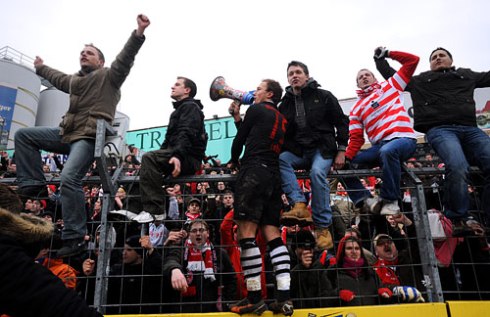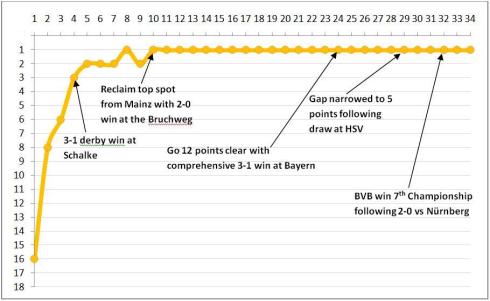Position: 18th
Average attendance: 24,258 (16th)
Number of sell outs: 11 (7th)
Top scorer: Gerald Asamoah (6)
Most assists: Gerald Asamoah (6)
Red cards: 5 (Asamoah, Bartels, Kalla, Kessler, Thorandt)
Most minutes: Matthias Lehmann – 2902
Season review (written by Leeds United and St. Pauli fan Scott Stubbs (@stubbsylufc))

Downhill from here: Asmoah celebrates his winner at Hamburg
It was a season that for quite a while promised so much, but in the end, the seemingly inevitable occurred. A football season often has defining moments. St. Pauli’s defining moment should have been February 16th 2011: the fixture highlighted by all St. Pauli followers when the fixtures for the season were announced, a short trip across the city to play Hamburger SV. St. Pauli recorded a historic 1-0 victory over their city neighbours. The result was a third successive victory, after two home victories against Köln and then Borussia Mönchengladbach. The defeat of Hamburg propelled St. Pauli up to 11th in the table, sitting comfortably on 28 points after 22 games. A club written off at the start of the season appeared to be on the brink of safety.
Unfortunately, the remaining twelve games saw St. Pauli suffer eleven defeats, picking up the only remaining point of the season in a 2-2 draw against fellow relegation-strugglers Wolfsburg. It was a catastrophic end to the season, which saw St. Pauli end the campaign at the bottom of the Bundesliga standings.
So where did it go wrong for St. Pauli? One big problem during the season was the loss of key players after the Christmas break – particularly in defensive areas. Ahead of the game against Hannover at the end of February, St. Pauli manager Holger Stanislawski – or Stani as he is known – resorted to calling up 30 year old press officer Hauke Brückner to the squad, due to the availability of only four fit defenders. Markus Thorandt, who played 29 times, was the only Pauli defender to play more than 20 of the Bundesliga games. These injuries came at a crucial time, and stopped the momentum that had been gathered by picking up three straight victories. In a squad that had the weakest financial backing in the league, the injuries were a major catalyst in their eventual relegation from the top flight.

Holger Stanislawski's last home game of an 18-year affiliation with Pauli was an 8-1 loss to Bayern
Another factor would be the obvious lack of goals scored. The top scorer was the marquee signing of the summer, Gerald Asamoah – who scored a mere 6 goals. Pauli scored 35 goals during the season, averaging just over a goal per game, but conceded 68 – including eight in one game against Bayern Munich. St. Pauli had earned promotion to the 2.Bundesliga with a free-flowing blend of attacking football, but they struggled to adapt this against better quality opposition. Asamoah often cut a frustrated figure playing as the lone striker in a 4-2-3-1 formation, and the lack of goals throughout the squad was something that could, and perhaps should, have been addressed.
Pauli also failed to make their home ground, the Millerntor, a fortress and had the worst home record in the league – picking up only four victories all season. The Millerntor perhaps ought to have been a difficult place for opponents to attend, with a fervent fan base and a small, intimidating ground, but it wasn’t to be.
St. Pauli also seemed to have a penchant for conceding late goals, which ultimately cost them points which could have been the difference in them surviving. During the barren spell after the victory against Hamburg, St. Pauli conceded in the last minute at home to Hannover 96 to lose the game 1-0, and also at home against fellow strugglers Stuttgart a couple of weeks later, to lose 2-1 in a game which they had led. They also led in the relegation battle against Wolfsburg away from home in April, but conceded a last minute equaliser to draw the game 2-2. You could put this down to naivety, or simply tired players with less stamina than their opponents who are more accustomed to the Bundesliga.
In the end, it was a mixture of bad luck, a lack of quality and perhaps a little naivety which saw St. Pauli relegated. It was a result that the vast majority of people had expected at the start of the season, but the way in which the season had fallen apart after the victory against bitter rivals Hamburg was remarkable.
Highlight of the season
The obvious choice, really. The 1-0 victory over Hamburg was the highlight for the ‘other team from Hamburg’. Gerald Asamoah’s 59th minute goal will live long in the memory of Pauli supporters. The celebrations after the goal and subsequently at the final whistle were akin to winning a trophy, with players and fans alike celebrating a huge victory that the club and its supporters had waited a long time for.
Low point of the season
From a footballing point of view, the obvious disappointment was the number of late goals conceded in vital games towards the end of the season when points should have been gained. Another notable disappointment was the 88th minute equaliser for Hamburg by Mladen Petric during the derby game at the Millerntor. However, the low point of the season has to be the beer-throwing incident during the game against Schalke at the Millerntor, where the linesman was hit during the closing minutes of the game by a plastic cup of beer that had been thrown from the St Pauli section.
Player of the season: Matthias Lehmann
A difficult choice, due to the injury plight of many key players during the season which meant many played a bit-part role, and also the lack of a goalscorer to claim the plaudits. Therefore, the selection has to be to Matthias Lehmann, who was almost an ever-present in the centre of midfield for St Pauli. With his composure on the ball, his dominance in midfield and his ability to act as a playmaker, Lehmann was the key man. Lehmann has joined Eintracht Frankfurt this summer, and will be a big loss to St Pauli next season.
Honourable mentions: Fabian Boll, Thomas Kessler, Carlos Zambrano
Best signing: Gerald Asamoah
Pauli’s big summer signing gave his all and never complained. Despite some rather ridiculous off the pitch behaviour – involving his wife, a mistress, a knife and some hamburgers – Asamoah finished the season with six goals and six assists in an ultimately failed bid to save Sankt.
What now for St Pauli?

Ex-Paderborn manager Andre Schubert will replace 'Stani'
With the loss of key player Lehmann to Frankfurt and Stani leaving to manage Hoffenheim, a summer of change at the Millerntor will be overseen by new coach Andre Schubert – previously coach of Paderborn 07. Pauli have already brought in three signings, goalkeeper Philipp Tschauner from TSV 1860 München, full-back Sebastian Schachten from Borussia Mönchengladbach and Lasse Sobiech who is a central defender on loan from Bundesliga champions Borussia Dortmund. The aim? Promotion back to the Bundesliga.
Season Rating: E
Another single season in the top flight for Pauli had more than its fair share of hope, but ultimately eleven defeats from twelve to close the season was simply too bad to survive.





